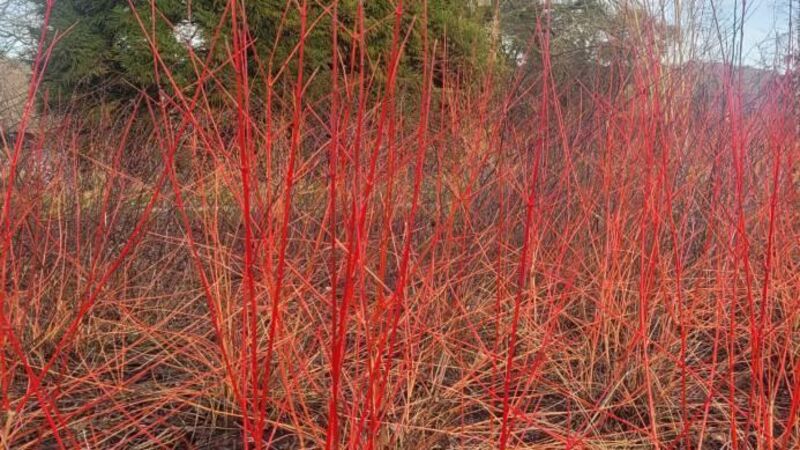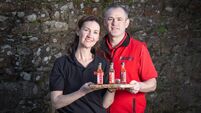In the Garden: Lay a hedge and help our wildlife thrive

The brightly coloured stems of Cornus ‘Annys Winter Orange’ make a great screen, providing a splash of colour in winter.
IT is back to the wind and rain after the cold snap earlier this January.
It was a chilly few weeks, but good, healthy winter weather that helps to keep pests at bay and kill off any overwintering nasties that can make it though a mild winter.
It is amazing the amount of wildlife that surfaces during the cold weather, as they forage for food that is increasingly scarce during the winter months.
Several foxes, owls, kingfisher, egrets, and herons were all spotted in the freezing snap we had, and it was such a thrill to see si many of these more elusive creatures appearing in their natural habitat.
When we experience plummeting temperatures, the realisation of the hardship endured by wildlife during these times makes providing shelter and habitat in our gardens very meaningful.
If space allows in your garden, it is a great idea to provide some shelter and refuge for nature to occupy during the harsher winter months.

Creating a dead hedge can be a great way of using woody prunings generated from trees and shrubs, and creating a habitat that provides screening as well as shelter and habitat.
To start your dead hedge, a double line of stakes needs to be hammered into the ground along the intended line of the hedge, and then the dead material can be piled up along the length within the stakes - they will contain the line and make the construction neater and more contained.
Hazel rods coppiced after two or three years of growth will make good stakes for this job. The material can be added to over the course of the year, and it can be useful to have an outlet for woody material that takes a long time to rot down on the compost heap.
If there was a very overgrown hedge, some hedge laying could also be considered, but this is only suitable for plants that will regenerate successfully from the base, such as whitethorn and blackthorn.
These were the most commonly used hedgerow plants for hedge-laying, but field maple, guelder rose, hazel, sycamore and holly will all respond well to hard cutting back.
Hedge-laying was traditionally practiced on farmland to create a stock-proof fence which livestock could not penetrate, and it entails cutting the hedging plants near the base, but not cutting right through the stem, leaving about one quarter of the stem attached to the root so that the plant will live and the cut will stimulate new growth from the base of the plant.
The cut stem is then laid at a 45 degree angle to allow the new growth to grow straight up from the base.
Hedge-laying results in a biodiverse habitat in hedgerows, with plenty of cover provided, which is great for the ecology and species diversity of the hedgerow.
It is a practice that is enjoying renewed interest and revival in recent years, as we begin to realise the importance of looking after the wider environment.
On a visit to Irish Seed Savers in Scariff, County Clare, last year, dead hedges and hedge-laying had been undertaken in the car parking area, demonstrating how effective and attractive they can be as a feature in the garden.
There were some pretty early flowering perennials growing at the base, like helleborous and pulmonaria which were taking advantage of the shelter provided at the base of the hedge - right plant, right place!
We are in the middle of hedge-planting season and garden centres are full of a selection of bare-rooted plants at this time of the year.
Planting a native hedge using a mixture of different plants provides a great resource for wildlife and can also provide material for use in the garden.
Hazel, cornus and willow are all particularly useful for annual or biennial coppicing of the stems which can be used for weaving or staking depending on the grade.
Remember when planting a living hedge that it does not need to be maintained as a neat, tightly cut square shape. It can be left to grow as a more natural boundary with some trees left within the hedge if space allows.
This is the time to plan and plant the hedgerow of your dreams to provide for nature and our own gardens, making our own small spaces more valuable and biodiverse ones.
Plant of the Week
Cornus sanguinea ‘Annys Winter Orange’ is a great plant for winter interest in the garden with its fiery red stems almost producing heat when encountered.
It is a deciduous shrub which can get to about two metres in height and spread. It will produce the best stem colour when coppiced to the ground each year in March or April. This will encourage the growth of new brightly-coloured stems for the following winter.
This also has good leaf colour in autumn and will do best in full sun or partial shade, growing in a moisture-retentive and free-draining soil.

The prunings from this shrub will provide some colourful material for a dead hedge, and they make a great starting point for a seasonal wreath when woven together in a circle.
They can also be planted into the soil to create new plants within a few months and they will root quite readily if planted in the springtime.
Choose pencil-thick stems about 30cm long and cut just below a node and insert into the soil.
These plants look great when mass planted and mixed with other varieties of colourful willow, rubus and cornus for a great winter effect in the garden.







 App?
App?


